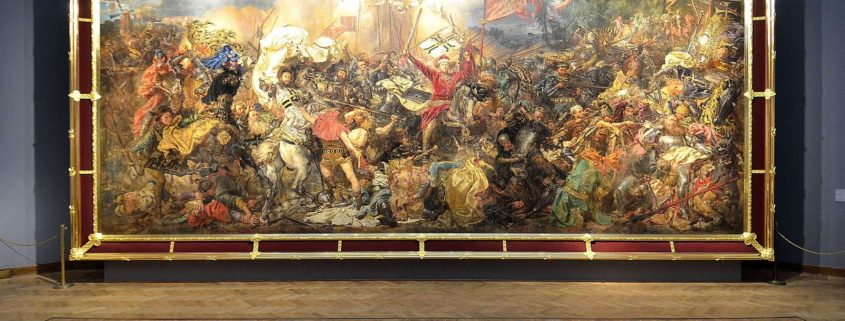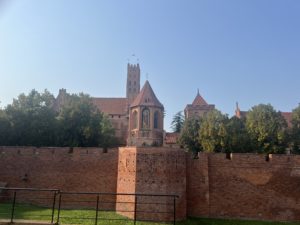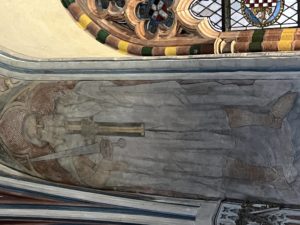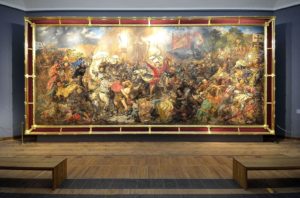Unity, Division, National Identity: 1000 Years of History at Malbork Teutonic Castle
By Nicholas Wilkerson
When our class visited the former East Prussian stronghold, known as Malbork Castle, it was safe to say I was in total awe. As a dedicated history major with a focus on the medieval period, I knew there was no historical site like Malbork Castle, home and capitol of the Teutonic Order, the deadliest enemy the upstart Polish-Lithuanian Commonwealth ever faced. Before entering the castle, I initially assumed the entire site to reflect our own home city of Wroclaw, an institution that formerly carried a strong German background before being destroyed and rebuilt from the ground up in a decidedly Polish image. However, what I observed was far more nuanced than a simple act of historical preservation.
Immediately upon entering the castle, I knew that I was extremely fortunate to see it from a purely architectural standpoint. So much of the original castle, as well as its Teutonic decoration, had been preserved over the years, allowing us to view so much history that could have very well been erased. Motifs such as the black eagle of the Teutonic Knights, and images of past Order Grand Masters were visible all over the castle, showing no signs of removal despite the fear they struck in the hearts of Poles, Lithuanians, and Baltic tribes alike, all of which comprised the Polish-Lithuanian Commonwealth. While we may never know why the kings such as Wladyslaw and Casimir IV retained these elements, it gives us a look at a history starting in the medieval period we could easily have forgotten due to neglect. Overall, the historical memory of Malbork Castle overlaps with many national myths connected to both German and Polish histories that played out in these lands.
For the Polish-Lithuanian Commonwealth, the battle and subsequent capture of Malbork was a triumph of the highest order, a symbol of victory over a brutal, hated enemy. However, for the eventual Prussian state, formed on old Teutonic land, the battle at Grunwald – known as Tannenberg by the Germans – remained a symbol of humiliation inherited by the successor states of the Teutonic Knights – Prussia and later the German Empire, which controlled much of partitioned Poland. By the time the First World War erupted, an early battle on the Eastern Front fought between the German Empire’s army and the Tsarist Russian army (which included conscripted Polish soldiers), took place on the very same land as in 1410, with the battlefield and even the factions being very similar. The Germans won the second battle of Tannenberg, a symbolic victory in which German leadership sought to avenge their humiliating defeat over 500 years earlier. However, Germany ultimately lost the First World War despite early success. After this defeat, a memorial to the victory at Tannenberg was built at the battle site in an attempt to lessen the humiliation of losing the war. The order for the construction of the memorial was made by the architect of the military victory at Tannenberg (and later the president of the Weimar Republic) Paul von Hindenburg, an ethnically Prussian nobleman. This memorial attempted to bury the past defeat by reminding Germans of their soldiers’ valor and success in the second battle of Tannenberg, allowing Germany to achieve a symbolic victory at a time of defeat. While the memorial was meant to honor the dead soldiers of 1914, it also honored the Teutonic Knights. After his death in 1934, Hindenburg himself was buried at Tannenberg, and celebrated as a great military leader much like the Teutonic Grand Masters before him. Therefore, it is safe to say that the events of 1410 were refreshed in the minds of many Germans at a time of Hitler’s rise to power and efforts to revitalize Germany as a European power.
This sentiment of humiliation at the hands of the Western Allies boiled over with the start of the Second World War, which began with the two-pronged invasion of Poland, by now a long-term enemy of Germany and the first steppingstone to European domination. The leaders of Nazi Germany, much like the Imperial German leaders before them, once again reached for old symbols of the past in their bid to conquer Poland, For example, the mission to eliminate the Polish leadership, intelligentsia and clergy was dubbed Operation Tannenberg, likely to remind the German SS units carrying out the murders that they were considered to be the successors of the Teutonic Knights exacting bloody revenge. Interestingly enough, Malbork Castle was used as a training site for Hitler Youth, likely to feed a similar notion of historical continuity of Nazi Germany finishing what the Teutonic Knights started. In addition, Minister of Propaganda Joseph Goebbels announcing an immense reward for a painting’s capture. This painting, created by Jan Matejko, depicted the Polish victory at Grunwald, so it was safe to assume that the Nazis sought to erase this history. For the course of the entire war, the painting was hidden from the Nazis and their efforts to obliterate all Polish culture. Much like the Teutonic Knights before them, the Nazis failed and were defeated.
Following the victory over Nazism after WWII, the Tannenberg memorial was destroyed by authorities in Communist Poland and largely forgotten. Malbork Castle itself had suffered severe damaged due to Soviet bombings at the end of the war. After the war, it was turned into a historical museum. In 1997, Malbork Castle was declared a UNESCO World Heritage site, meaning that the castle and its long history tied to multiple countries and empires (Polish-Lithuanian Commonwealth, Prussia, German Empire, Second Republic of Poland, Nazi Germany, Poland in the post-1945 era) achieved a status that transcended current national borders and national memories. While it may seem that the narrative recounted today leans more in favor of Poland than Germany due to the Tannenberg memorial not being rebuilt, the castle, now a museum, gives equal attention to both the Teutonic Order and the Polish-Lithuanian Commonwealth. Again, this is a clear sign of a more united Europe, mostly free of the division and hatred that plagued the continent for the longest time. However, some nationalist Polish movements, known for their anti-EU sentiment, still reference the Polish victory in the battle of 1410, using it to express their sentiment that Poland is on its own and cannot trust any of their neighbors. While Germany and Poland are today close allies and trading partners, largely free from the long-standing historical rivalry that began with the Teutonic Knights, it is possible that feelings of division and outright hatred could resurface, a negative outcome of historical memory. While the future of a united Europe is yet to be written, Malbork Castle teaches us that the memory of past historical events often reemerge in the present, opening old wounds that sow deadly conflicts in the future.







